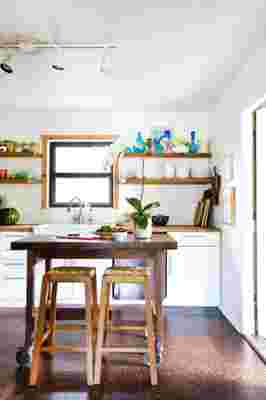
Ah, cork: the kind of trusty, do-it-all material that helps ensure sparkling wine stays as fizzy as possible, mood boards are properly tacked up, that your wedges can carry you jauntily through early spring days. Did you know cork’s eco-friendly origin and peerless durability also make it an increasingly popular choice for home flooring though? Whether you’re in search of a material that will help absorb sound in a rowdy toddler’s playroom or a plant-based floor that’s simple to DIY, cork might just be the right material to “pop” up in your home.
Into The Woods
First, a little natural backstory. Cork is the outer bark of the cork oak tree, which — after being stripped of its bark — regenerates roughly every nine years, making it a material that’s truly a renewable resource. A large majority of cork oak trees grow in Portugese forests known as montados , where the cork bark plays a critical role in helping stave off wildfires and provides habitat for a diverse menagerie of animals. The bark stripping process doesn’t harm the trees in the slightest, and if you can believe it, this actually helps them to thrive for upwards of 250 years. Isn’t nature just amazing? After the bark is stripped, it’s ground, cured, and pressed into sheets, planks, or tiles that will, eventually, be made into flooring. Cork flooring is also frequently manufactured from the recycled waste material left over after creating wine corks and other bottle stoppers, making its eco-friendly bonafides even that much stronger.
Put a Cork In It
Springy and light with almost a velvet-like texture, cork flooring is an ideal choice for anyone with lower back, foot, or knee problems, thanks to its flexibility. Cork’s also a strong choice in areas where standing for a long time is the norm like the kitchen (just be sure to use a sealant on top to protect your floors from moisture). Its buoyancy underfoot is only matched by its warmth and ability to retain heat, which makes it perfect for bedrooms, playrooms, or any space where going sock- or slipper-free is preferred. In fact, because cork is naturally anti-microbial — thus, mold and mildew resistant — allergy and asthma sufferers will benefit from the flooring’s outright rejection of dust mites and dander. If you’re looking for a way to push back against springtime sniffles, cork could be a good choice. Highly durable and moisture-wicking due to its innate properties from being plant-derived, cork’s just as suitable for a high-traffic living room or entryway as a sunroom and requires very little in terms of cleaning and maintenance: Simply use a broom or light mop to clean up messes without fear of staining (I’m looking at you, tile and carpet). If you’re on the hunt for flooring that will help keep noise contained to a single space, cork should be your go-to. Its sound absorption skills mean that a teen’s drum practice can stay in their own bedroom and not echo throughout the entire home. Once again, what can’t cork do? Cork flooring traditionally looks like, um, a cork — a design choice that is decidedly not for everyone , but new versions have been developed in recent years that have the appearance of everything from marble to classic hardwood . So even if you’re not quite on board with your living room floors resembling bottle stoppers, you can take advantage of cork’s environmental benefits.
Even You Can DIY It (Really!)
Cork flooring comes in tiles and planks that are almost effortless to install for even the least handy among us, as long as you’re working with a dry, level subfloor. Some are self-adhesive , others require glue, and another category uses a “floating floor” technology to click and lock. One thing’s for sure: It’s far simpler to arrange these cork pieces, Tetris-style, than deal with the dust and nails of hardwood or the major machinery required for carpet install. Running between $3 to $8 per square foot on average, what you save in installation costs and longevity — almost all cork flooring is guaranteed to last at least 15 years — will more than make up for the slightly pricey materials. Plus, you get to live with the knowledge that your flooring choice is one of the most sustainable on the market. That fact is, well, priceless.
